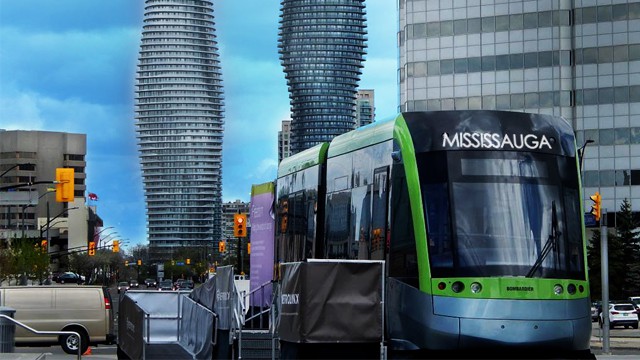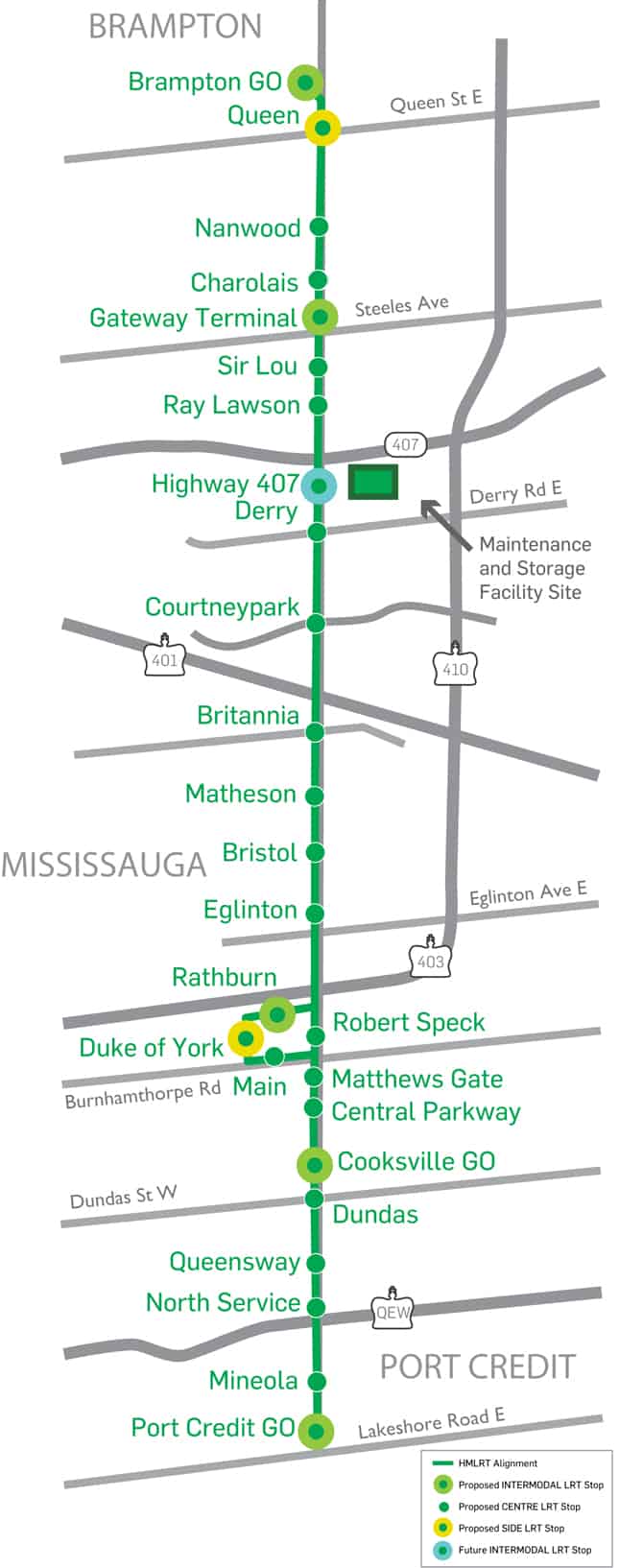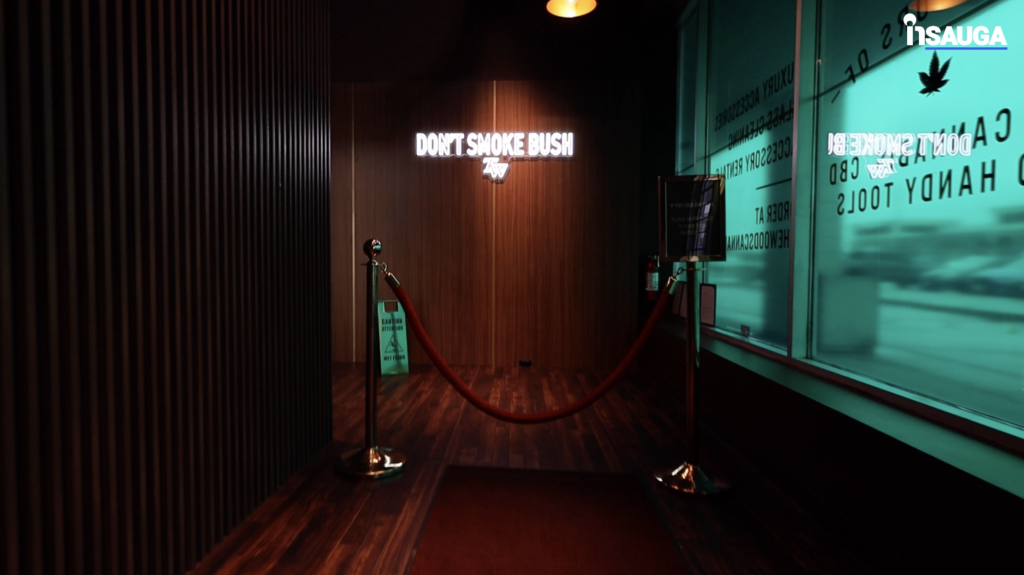inFeature: The Truth Behind the LRT in Mississauga
Published November 25, 2015 at 10:41 pm

Nando Iannicca, the councillor of Ward 7, was elected to serve his ninth term in office last year. Not only has he served his ward since 1988, he’s representing the area he grew up in. His father immigrated from Italy to Cooksville many moons ago and Iannicca was born at Trillium hospital and spent his first years in a house on King Street. His city hall office is spacious and comfy, and when we sat down opposite each other on cushy leather furniture, I knew we were about to have a candid and colourful conversation.
The topic?
The Hurontario-Main LRT, the fast-approaching, fully-funded Metrolinx transportation project set to take shape along Hurontario from Lakeshore to Brampton. Where the train will go once it leaves Mississauga is a great mystery, as Brampton has refused provincial funding for the proposed line. We wanted to find out more about the project’s potential impact on the community in general and small businesses in particular.
After talking for almost 40 minutes, we got on the topic of China. About three years ago, I stepped off a plane in Beijing, tired and violently ill from a queasy last day in — and tumultuous journey from — Kathmandu, Nepal. I had expected Beijing to be everything it was — grand, historical, modern, urbane, cool and bustling. It was also polluted, but the omnipresent mist didn’t detract from the grandeur of the vast, legendary city (which might have been because I was a temporary visitor and not a resident exposed to it every day). What struck me was how easy it was to make my way from one end of the enormous city to the other. In a few short minutes, I could move from the Forbidden City to the silk markets to the nightlife districts. Even though China suffered through tremendous poverty and upheaval for the better part of the 20th century, it developed its capital and landmark cities admirably.
Beijing moves people — a lot of them. It’s not perfect, but it’s not inefficient either.
“People go to cities,” Iannicca says. “The metropolis makes sense. You go there for a doctor, a dentist and funky boots. In China, all of Canada basically moved into Port Credit and we’re afraid of an LRT. Our biggest problem is that we had to come together with a lot of hamlets and towns and decided to act as one big town instead of one big city. If China can move all those people, how can we be afraid of a train?”
To say that Iannicca is passionate about the train is understatement. When he talks about the LRT, he doesn’t just talk about an additional mode of transportation for the city to utilize, he talks about growth, revitalization and epic, positive change. While his confidence and excitement is palpable and encouraging, it belies something bigger — grand vision.
“There’s trepidation, but you’ll love the Cooksville of the future,” he says. “We’ll never be NYC or Rome, but we can be a Portland, or Seattle or Barcelona. It’s right in front of us, and with the LRT, it’s a reality.”
When I reached out to Iannicca, it was to find out what small businesses in and around the proposed construction route thought about the project. I had attempted to interview local shop and restaurant owners, but most people who got back to me were unaware the train was coming at all. Some who were aware were still puzzled by my inquiry.
“What does a train have to do with a restaurant?” a local restaurateur asked me, good-naturedly, over the phone.
For many residents and business owners, the day to day grind is top of mind. A seemingly futuristic project that is years away from breaking ground simply isn’t resonating with people who have customers to serve, locations to grow and bills to pay. When I asked the councillor if local business owners have been engaged in the consultation process, he said he was surprised that few were making it out to meetings and presentations.
“It’s very peculiar,” he says. “We haven’t interacted with small business owners as much as we would like. The mayor and I are going to convene a meeting and I’ll be handing out flyers to all the small business owners.”
That said, it appears that some who have weighed in are nervous about the project.
“I’m excited that this is the world that is unfolding and it presents a marvelous opportunity. The second thought I have is that it’s remarkable some of the positions that some of the owners and merchants have. It’s ‘oh, oh my god!” I beg your pardon – you’re the same people who have elected me and told me to clean up Cooksville and Hwy 5 and 10,” he says, laughing. “Cooksville works, but it’s a little rough around the edges. This will revitalize the area. People have been telling me this for three decades and I finally hit a homerun. This is a tremendous opportunity.”
In terms of development, this project did not appear out of thin air.
“Before Hazel McCallion [became mayor], it was determined that Mississauga was a growth node by the province of Ontario,” he explains. “In the next 30 to 40 years, the greater Toronto and Hamilton areas will be adding the populations of Vancouver and Montreal. Our official plans always said this was coming and now the province has gotten to a point where, since we’re following their game plan and need higher order transit, they’re funding it fully. I’m shocked. I thought my career would have run out before we started building it.”
The fact that the city will grow exponentially is a salient point. LRT detractors tend to argue two things: one, that the city can’t afford it and two, that it’s simply not necessary. Ridership, some say, will be embarrassingly low in a city where people like their cars and, should they not drive, are adequately served by MiWay’s bus system.
Since the province is funding the project, it’s no longer feasible to argue against enhanced municipal costs. As for buses serving the community, what might be efficient now won’t necessarily work in 10, 20 or 30 years. What’s most interesting still is the shock some critics experience when they hear that the project is indeed imminent.
“We built a downtown core and we can’t keep servicing [the city] on a bus line,” Iannicca says. “So higher order transit is needed and, for a change, it’s government doing exactly what it said it was going to do. It’s kind of remarkable that it’s upon us.
To be clear, the engineering and design have been done for a long time, along with the environmental assessments. We’ve had about 11 or 12 public meetings on it. We had a prototype of what one of them would look like in front of City Hall for a while. You can send out newsletters, but until people see it in front of their home, they say, ‘what’s this? When did this come up?’”
In terms of survival, the construction process — which Iannicca projects will take about four years total and will follow a two-year engineering process — will be arduous and challenging.
Will every mom and pop shop survive the upheaval? Maybe.
But maybe not.
“It’s not going to get done overnight,” he says.” “[Shops] might have to move across the road in an interim way. We’re not tearing everything down at once. What’s disappointing is that everyone is focusing on the next four or six years. It’s going to be difficult. I don’t lie to anybody. It’s going to be horrific. I can’t change that. We’re going to do it efficiently and keep lanes of traffic open all the time, but in the history of these things, no one has ever built [something like this] and had the community say “that went pretty easily!” It’s the nature of the beast. Having said that, years later it’s “wow!’”
When talking to Iannicca, it’s clear that this is a big picture project. When I’ve spoken to Metrolinx, representatives have often said that the train is simply a solution to traffic concerns. It’s not being designed to eliminate traffic, but rather alleviate it as the city grows. For the councillor, the train isn’t merely about moving people — it’s about reinvigorating an entire city and Cooksville in particular.
Cooksville, known for the 5 and 10 intersection that’s home to an incredible and diverse swath of businesses and people, is aging. It is, as Iannicca put it during our chat, “a little rough around the edges.” Ideally, a new train will bring new developments, new businesses and new opportunities for existing businesses.
“God bless people who don’t think Cooksville needs revitalization” he says, earnestly and honestly. “I was born and raised here. People say it looks tired, but there are no empty store fronts. I can walk you into Cooksville and take you to jewelers who sell $100,000 watches and car dealerships that sell $400,000 McLarens.
Cooksville works. Those kids studying at TLK will be doing brain surgery at the hospital in a few years. I know it works, but the facelift is long overdue. All cities rebuild themselves. It takes about a 100 year cycle, but it’s time for our great opportunity. This is going to be a challenge, but an overwhelming opportunity. If we get it right, we might live in the most livable, workable and fun please to [play] in the GTA.”
When chatting about the LRT, Iannicca is careful to emphasize the future. He’s also refreshingly candid about what the city — or North America in general, really — has done wrong in regards to metropolitan infrastructure (namely not having enough of it). He also says the train is an exercise in place-making. With multiple intra-city stops and quick turnover, the route itself will, he argues, become a destination. People will hop off to stop at old school Cooksville favourites or try a brand new shop or fusion restaurant. Residents won’t necessarily look east for entertainment.
“I ask my residents to not get caught up on the how, but get excited about the what. I’d rather take a bullet in the head than go to downtown TO. I have to drive 22 minutes to where I’m parking my car. Imagine people saying, “Oh my god, I just walked onto an LRT in Mississauga and got where I needed to be in 17 minutes. It cost me $2 and I don’t have to fight with the rest of the world and I can have a drink or two. Now that I built an LRT, people will rent space at 5 and 10 and residents will walk from their buildings on Hurontario, take the LRT and not have to worry about driving or parking. They can have a drink or two and get home in 17 minutes.”
The drink part is especially relevant, even though it seems frivolous. A couple years ago, we interviewed Natsuhiko Sugimoto, the executive chef at TO’s Guu SakaBar and asked him if the brand would ever open a location in Sauga. He said that while the resto was interested in the area, there were concerns about a lack of public transportation surrounding an establishment that’s known for serving abundant drinks.
Not being able to get home easily after a few drinks is a problem in an objectively big city.
As for revitalization, it would appear that change is already in the works.
“Once the thing is built, it is going to take off like a rocket ship,” he says. “It’s happening now. People are interested in the land now. People are thinking of revitalizing now. Four or five years goes by pretty quick when you’re working on a big project – and there are permits and steps that take time – so they’re going to be ready for the grand opening.”
When asked why a north/south line was chosen over an east/west one, Iannicca says the first train is only the beginning.
“I’m not selling a vision, it’s a fact. We have great bones. We have density and can accommodate more people. It’s a very multi-cultural part of the world, as relates to food and products. The transportation infrastructure is scary good. I can still take a bus to Islington or Kipling to go downtown. And after the north/south LRT is built, the [east/west] one is next. Try and stop it!”
For some, the LRT might still seem like something to worry about later — and it is. It’s certainly not going to be built tomorrow. But, as Iannicca said, the years go by quickly when a project is in the works and 2017/2018 will be here before we know it. Knowing that there’s a grand and ambitious (but workable) vision behind it, now is a good time for everyone (but namely residents and small business owners in the corridor) to start preparing.
Running a business isn’t easy,” he says. “In April, things changed and the future came early. In two years, we’re starting. In fairness to [business owners], they might have asked ‘Nando, when is this starting?’ And I could have said, ‘I don’t know, maybe after I’m dead,’ but that’s all changed. Now it’s for real, so we have to ramp up the communications and we are, starting with the meeting I’m having next Thursday. There’s a meeting with the business community that the mayor will be attending in the spring and we might have another half-dozen meetings before we stick a shovel in the ground. It’s going to come with a great deal of growing pains. I’m asking people to look past it.”
Proposed Hurontario-Main LRT Route Alignment

INsauga's Editorial Standards and Policies









